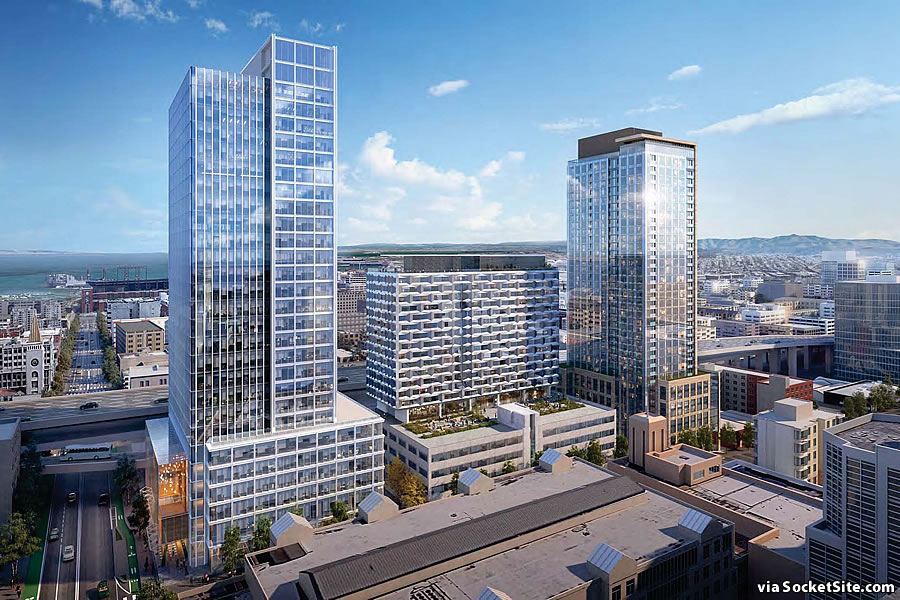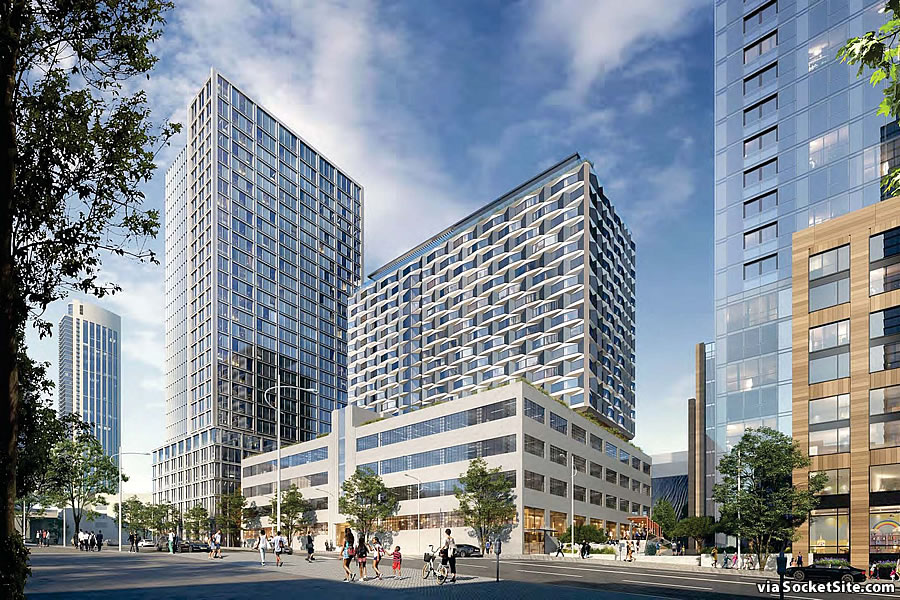The proposed mass redevelopment of 12 contiguous Central SoMa parcels stretching from 400 Second Street to 665 Harrison, a.k.a. the One Vassar project, has just qualified for a streamlined environmental review and could break ground as early as next year if approved, with two towers rising up to 350 feet in height and a modern addition atop the historic building between.
As designed by Skidmore Owings & Merrill (SOM), the refined plans for the 400 Second Street tower would now yield 446,000 square feet of office space, with 5,100 square feet of ground floor retail space, a basement garage for 198 cars and 6,300 square feet of privately-owned public open space (POPOS) fronting Second Street, half of which would be enclosed.
On the other end of the site at 657 Harrison Street, a 35-story residential tower designed by Solomon Cordwell Buenz (SCB) would yield up to 489 apartments, with a 14,000-square-foot childcare facility, 1,700 square feet of ground floor retail space and a basement garage for 128 cars.
And atop the historic building at 645 Harrison Street, a modern 15-story addition designed by SOM would rise to a height of 200 feet and yield a new 468-room hotel.
At the same time, the first floor of the existing 4-story building at 645 Harrison Street would be converted into 24,000 square feet of new restaurant and retail space, configured as a “market hall,” with 65,000 square feet of office space, and 44,000 square feet of PDR, spread across the floors above and an adjacent 8,400-square-foot Hawthorne Street Plaza connecting Harrison and Perry.
And if approved, the project team is touting the potential for breaking ground for the two towers in mid-2021, with the redevelopment of 645 Harrison Street beginning in mid-2022 and the entire development completed by late 2024. But the project team will need to secure an increasingly scarce office allocation for the project to be permitted as proposed, an allocation which could be flipped.
We’ll keep you posted and plugged-in.


This project does a good job fulfilling the Central SoMa Plan’s policy of utilizing new buildings to diminish the dominant presence of the freeway:
“The elevated I-80 freeway slices through the Plan Area. While the freeway structure is relatively low (30-50 feet), it looms large above the low-slung buildings on either side and creates a physical and psychological divider of the neighborhood. Where the City is increasing development potential, it should allow buildings to be taller than the freeway. This will help diminish the presence of the freeway while integrating the areas on either side.”
– Central SoMa Plan, § 8.3.7
Agreed.
At the risk of repeating, the freeway will probably eventually be capped with a parkland, bike/pwd lane several miles long. OK fast forward 25 years but Salesforce Park shows what an elevated park can look like. As SOMA densities, the absence of green space will only become more apparent.
There’s really no feasible way to cap an elevated freeway like that. Yeah, it’s physically possible, but nobody is going to throw money at that kind of project, even if it would be great if money were no object.
Many cities are discussing capping freeways with parks (LA, Austin, Seattle, NYC); there are a variety of ways to fund it include private and public partnerships. One big tech CEO could pay for it easily.
Seriously, show me a single ELEVATED freeway being capped, because I sure as hell can’t find any.
But I agree that capping sunken or semi-sunken freeways is a good idea and a worthwhile expenditure. I can think of several places in the city that would benefit from it.
Here is an example of a semi capped freeway with a park.
Here’s the original Freeway Park in Seattle that straddles a surface and an elevated freeway.
I have been to both of those parks. Neither of them is constructed in top of a freeway that is above the grade of surrounding surface streets, the way that the 80 approach to the Bay Bridge is elevated above surrounding streets. Both are caps on sections of freeway below the grade of adjacent surface streets. What was described above is more like constructing a much longer Transbay Center park way above street level above the already elevated highway. That doesn’t exist anywhere I’m aware of.
To offer some insight:
Capping sunken/at-grade freeways is a very cool and worthwhile concept and I support it nearly universally. With that said, capping an ELEVATED freeway is orders of magnitude more complex. The reason for this is that capping involves adding additional structure and, in the case of parks, a loooot of soil to support the plants that are intended to grow on it. The end result is that you’ve added a considerable amount of mass to the top of this elevated structure. This can obviously create issues for the pylons of the elevated freeway to handle the added weight… but that pales in comparison to the issues it creates when you do seismic calculations. All that mass is not being added at the very worst location (the top) when it comes to seismic calculations and the calculation of the lateral forces that they produce. Adding that much mass (and it truly is a hug amount of mass) would require essentially rebuilding the entire elevated freeway structure (not that that isn’t a theoretical option but would require much much greater time and cost investment).
The other elevated park that is cited, Transbay Terminal, is an example of how oyu can make these calculations (including the huge soil load up top) work. Fortunately they were starting from a blank slate, so could design the structure appropriately from the get go. Unfortunately the addition of the park added a considerable cost to the project.
So in short… anything is feasible, but capping an elevated freeway with a park would not be as simple an undertaking as maybe it seems at first blush.
In addition to being expensive for the reasons that Medium D describes, the value of parkland is inversely related to its height above street level. The higher the park, the more stairs people must climb. At about twenty feet above the street Manhattan’s High Line is about the limit of what should be considered. The Transbay park is too high though that is mitigated by the fact that there will already be significant amount of people already on the bus terminal level as well as the connecting overpasses from surrounding buildings.
FRONOFRO & Hunter: both the Dallas and Seattle parks are above depressed, not elevated freeways. C’mon.
San Francisco isn’t even a city full of freeways like LA, Seattle, NYC, etc. I-80/101 are the only ones that run through the entire city. The only freeway that is being capped is the Presidio freeway, which will hold a brand new park on top of the tunnel. San Francisco will not look into capping 1-80 as it is elevated and there’s just no room to make any type of elevated area in that specific area. It’s too dense. Just wouldn’t make any sense. Especially coming off the bay bridge, with multiple exits and entrances. Wouldn’t happen.
NYC is not full of freeways whatsoever. And Seattle has 2. Weird take.
The best thing we could do with the current freeway is to make walking under it more inviting. Crossing under most of the elevated freeways in SF (101 near Potrero, the entire Central Freeway, the section of the 80 we’re talking about) is an exercise in intestinal fortitude. Avert your eyes and hold your breath, despite the fact that you’re in the middle of some of the most expensive areas in town! It doesn’t have to be this way!
They aren’t really looking at this from a street level perspective. Turning the surface into a bunch of dark canyons may “diminish” the presence of the freeway but doesn’t really ameliorate it. Any excuse to build, I suppose.
One of the best (if not THE best) elements of the central SoMa plan is upzoning of the parcels next to the freeway. There’s little of historical interest in the buildings on those parcels, and the idea of screening the freeway is brilliant.
i think this project looks amazing. Even though its more of the same in terms of the glassy bland boxy look its still a nice project for that location, and at least the lower / middle building has a little character….granted I think even that looks more like a 60’s or 70’s style building. Either way i like this & hope to see it get started on time.
But I wish we would get some more creative towers on the skyline.
Agree, and I love that the hotel looks like a throwback to the Jack Tar era. 😉
Agree this project looks amazing. Particularly the way the trio of buildings (and their pedestals) play off each other. The middle is the most interesting, taking a tired office building and reinventing it with a retro looking tower.
That’s a LOT of mediocre in one project, not one structure is interesting or innovative, could be anywhere! Very Sad. Planning not doing a good job, just say NO!
This sort of sentiment is divorced from reality. There isn’t a single city in the world where every, or even the majority of, building (even if you only look at high rises) is particularly unique or architecturally notable. It’s hands down the worst reason to reject a project.
100% Agree, maybe Derek feels we should slap some bay windows on it.
How is 645 Harrison ‘historic’? It’s bland and ugly.
Because “bland and ugly” are not among the criteria used to determine historic significance.
UPDATE: Big Central SoMa Project Granted Key Exemption, But…